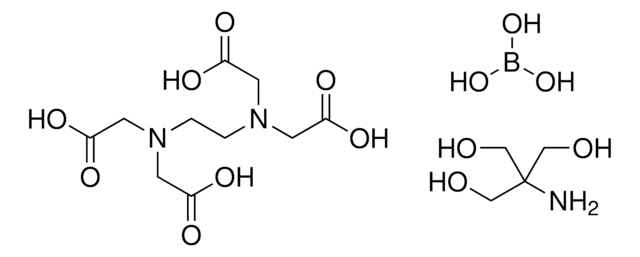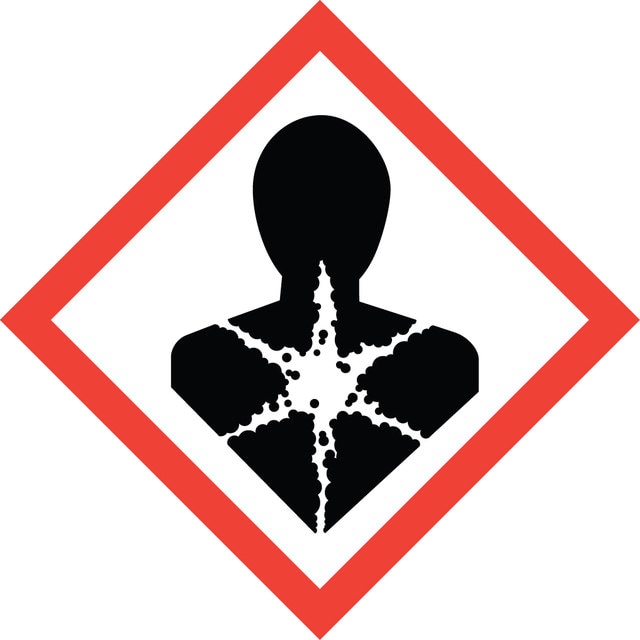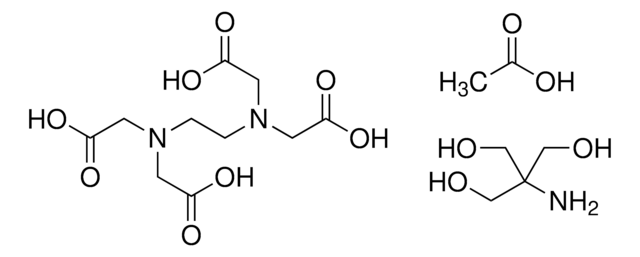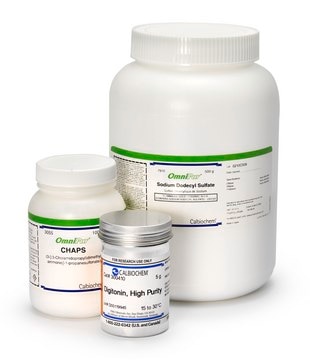T7527
Tris-Borate-EDTA buffer
BioReagent, for molecular biology, 5x concentrate, DNase and RNase, none detected, powder blend, suitable for electrophoresis
Synonym(s):
TBE buffer
About This Item
Recommended Products
grade
for molecular biology
Quality Level
product line
BioReagent
form
powder blend
impurities
DNase and RNase, none detected
pH
8.1-8.5 (5 ×)
solubility
water: 85.1 g/L, clear, colorless
suitability
suitable for electrophoresis
application(s)
diagnostic assay manufacturing
SMILES string
OB(O)O.NC(CO)(CO)CO.OC(=O)CN(CCN(CC(O)=O)CC(O)=O)CC(O)=O
InChI
1S/C10H16N2O8.C4H11NO3.BH3O3/c13-7(14)3-11(4-8(15)16)1-2-12(5-9(17)18)6-10(19)20;5-4(1-6,2-7)3-8;2-1(3)4/h1-6H2,(H,13,14)(H,15,16)(H,17,18)(H,19,20);6-8H,1-3,5H2;2-4H
InChI key
OSBLTNPMIGYQGY-UHFFFAOYSA-N
Looking for similar products? Visit Product Comparison Guide
Related Categories
Application
Dilution of the TBE stock concentrates to a 1× TBE running buffer results in a buffer containing 89 mM Tris-borate and 2 mM EDTA, pH 8.3. The 5× or 10× stocks may also be added to an acrylamide/bis-acrylamide stock solution for making the PAGE gel. Applied voltages of less than 5 V/cm (distance between the electrodes of the unit) are recommended for maximum resolution.
Packaging
4L poly bottle contains a powder blend that can be dissolved and reconstituted to prepare four liters of a 5× concentrate.
Preparation Note
Reconstitution
signalword
Danger
hcodes
Hazard Classifications
Repr. 1B
Storage Class
6.1C - Combustible, acute toxic Cat.3 / toxic compounds or compounds which causing chronic effects
wgk_germany
WGK 1
flash_point_f
Not applicable
flash_point_c
Not applicable
ppe
Eyeshields, Gloves, type P2 (EN 143) respirator cartridges
Certificates of Analysis (COA)
Search for Certificates of Analysis (COA) by entering the products Lot/Batch Number. Lot and Batch Numbers can be found on a product’s label following the words ‘Lot’ or ‘Batch’.
Already Own This Product?
Find documentation for the products that you have recently purchased in the Document Library.
Customers Also Viewed
Related Content
Nancy-520 for DNA Detection and Quantitation
Our team of scientists has experience in all areas of research including Life Science, Material Science, Chemical Synthesis, Chromatography, Analytical and many others.
Contact Technical Service





